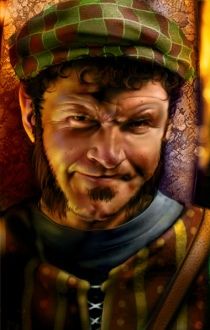What a utterload of shit, my friend! You may fool these good people of Codex, but if you try to do so with old, respected sages of tabletop (aka Planescape nerds), you better be prepared to face consequences of
cherrypicking art!
Here, let us follow with some table that you SHOULD use when you roll up a real tiefling, not 5e porn shit, nor really lucky one to end up with only a tail! (Truth be told, there are some tieflings like that, but you can end up with quite charming monster or fucking half-image of Ravel Puzzlewell!) And mind you, it isn't only look bullshit, it is also about useful or esoteric stuff!:
The image I posted was drawn by Tony DiTerlizzi and is from the entry on Tieflings from the Monstrous Compendium Planescape Appendix I, published in 1994, two years before The Planewalkers Handbook (written by Monte Cook) from which you've taken that table. To refer back to the Planescape Campaign Setting Box Set description of tieflings (written by David Zeb Cook):
In the multiverse, few creatures are of pure lineage, and even fewer are what they seem to be. That's the greatest truth of the tiefling's existence. It's not advisable to ask a tiefling about his or her ancestors, as the answer wouldn't likely be pleasant. Part human and part something else, tieflings are the orphans of the planes. They can be described as humans who've been plane-touched. A shadow of knife-edge in their face, a little too much fire in their eyes, a scent of ash in their presence - all these things and more describe a tiefling. No planar would mistake a tiefling for a human, and most primes make the mistake only once. Tieflings live with both pride and shame of who and what they are. They have no culture of their own, and most are loners, which fits their background. Some slip into the edges of human society, becoming poets and artists who describe the corrupt fringes of the respectable world. Adventurous types often spend their years probing the unexplored edges of the multiverse, be it to survey strange lands or experiment in the forgotten niches of magical science.
Humans don't trust tieflings (and deep inside they fear them), but they remain inexplicably fascinated by tieflings just the same. The plane-touched are often accused of secret plots and awful alliances — mostly without a shred of proof — because of who and what they are. A tiefling learns early that life is unfair and hard. His reaction is to fight back and never let his foes see the pain.
Other people, even other tieflings, simply aren't viewed as allies and often are automatically considered enemies. A tiefling doesn't take a friend until he learns the measure of his companion, and even then he'll never fully trust anyone. "I watch my own back," is an old tiefling quip. They maintain no hereditary blood-feuds, but tieflings take care of themselves without any thought of others' problems.
Tiefling characters gain a
+1 bonus on Intelligence and Charisma scores, but suffer a -1 penalty to Strength and Wisdom. Tieflings can be of any alignment save lawful good. They also gain a number of special abilities, based on their mysterious heritage: They possess infravision to a range of 60 feet and have the ability to create darkness, 15-foot radius once per day. Tieflings suffer only half damage from cold-based attacks, and they gain a +2 bonus to all saving throws vs. fire, electricity, or poison.
Tieflings can be fighters, rangers, wizards (including specialist mages), priests, thieves, or bards. They may also pursue multiclass options, including fighter/wizard, fighter/priest, fighter/thief, wizard/thief, and priest/thief.
This image of tieflings accompanied the tables you posted from The Planewalkers Handbook; Annah from Planescape: Torment

























